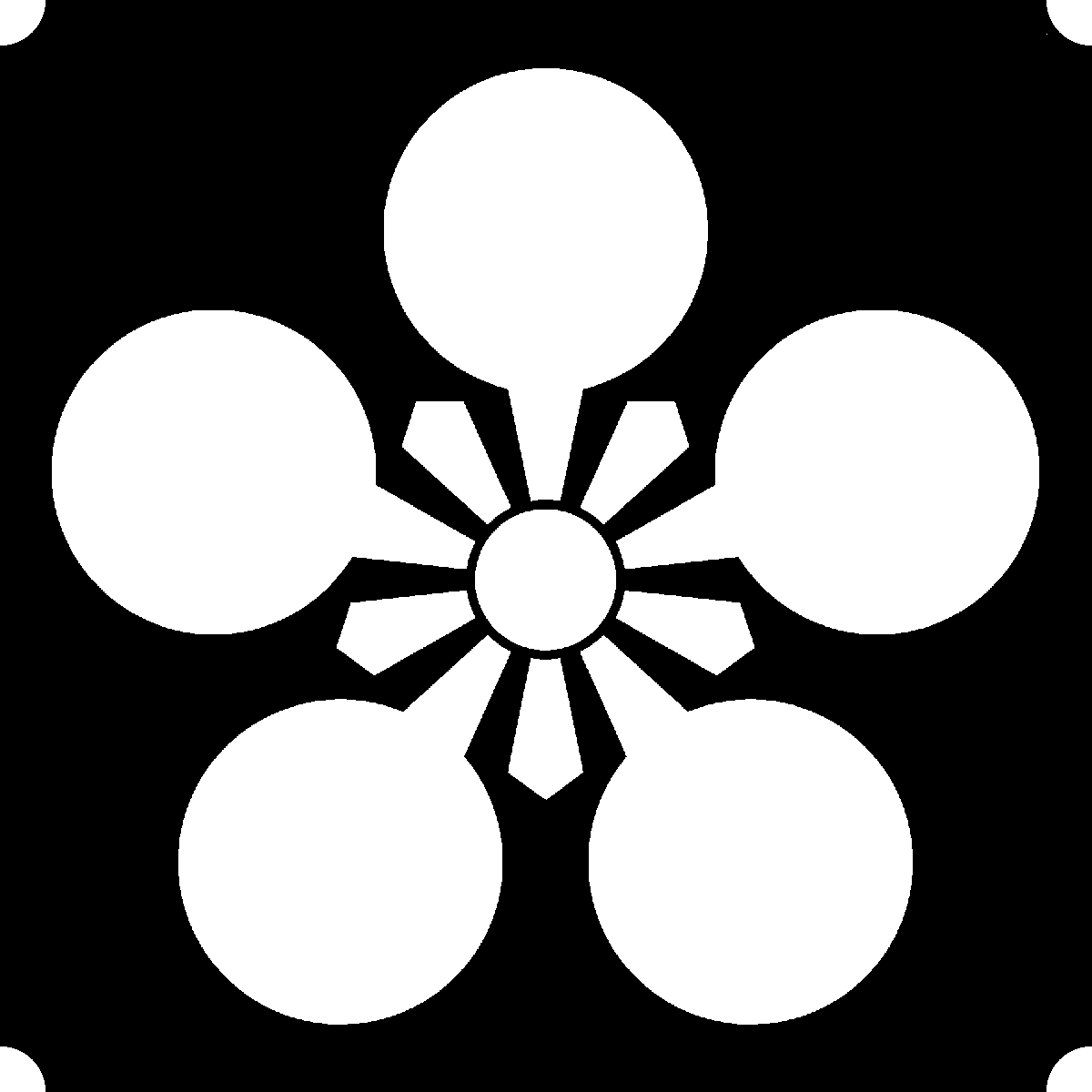|

DAIMYO of
KAGA PROVINCE
Maeda


- Domain: Kanazawa
- Stipend: 1,025,000 koku
- Class: Tozama 4
- Headquarters: Kanazawa Castle (Hilltop)
%20800x301.jpg)
%20800x533.jpg)
%20800x533.jpg)
%20518x599.jpg)
Family of daimyo who came from Owari and descended from Sugawara Michizane
(847-903).
Senior branch.
Succession
- Toshiie (1538-1599)
- Toshinaga (1562-1614) - 1st Maeda daimyo of Kanazawa (1599-1605)
- Toshitsune (1593-1658; daimyo 1605-1639)
- Mitsutaka (1616-1645; daimyo 1639-1645)
- Tsunanori (1643-1723; daimyo 1645-1723)
- Yoshinori (1690-1745; daimyo 1723-1745)
- Munetoki (1725-1747; daimyo 1745-1746)
- Shigehiro (1729-1753; daimyo 1746-1753)
- Shigenobu (1735-1753; daimyo 1753)
- Shigemichi (1741-1786; daimyo 1753-1771)
- Harunaga (1745-1810; daimyo 1771-1802)
- Narihiro/Narinaga (1782-1824; daimyo 1802-1822)
- Nariyasu (1811-1884; daimyo 1822-1866)
.JPG)
- Yoshiyasu (1830-1874; daimyo 1866- )
Notable Ancestors
-
Maeda
Toshiie (1538-1599)
.jpg)
.jpg)
Served Nobunaga at first, who intrusted to his keeping the castle of Arako
(Owari). After the destruction of the Asakura (1573), he established himself
at Fuchu (Echizen -- 33,000 koku); in 1581 obtained the province of Noto; then
in 1583, that of Kaga. During the campaign against the Hojo (1590), he,
together with Uesugi Kagekatsu, received orders to take the castles in Kozuke
and Musashi. At the time of the Korean expedition (1592), he accompanied
Hideyoshi to Nagoya (Hizen), and directed military affairs from that place,
when the latter returned to Fushimi. He was one of the five tairo who had been
appointed governors during the minority of Hideyori and it is to him more
particularly that the Taiko, at the point of death, confided his son. It is
then not astonishing that he tried to combat the ambitious views of Ieyasu; he
died the following year. Toshiie is often called Kaga-Dainagon.
-
Maeda
Toshinaga (1562-1614)
.jpg)
Eldest son of Toshiie. Like his father, he tried to prevent civil war, but did
not succeed. Having no children, he adopted his youngest brother Toshitsune,
who was betrothed to a daughter of Hidetada, whilst he himself married a
daughter of Ieyasu. In 1600, he joined in the campaign against Uesugi
Kagekatsu, and after the battle of Sekigahara, obtained the domains of his
brother Takamasa (Noto -- 215,000 koku), who had fought on the side of
Hideyori. His income was then 1,250,000 koku, a wealth never attained by any
daimyo under the Tokugawa. He erected the castle of Kanazawa (Kaga), and
resided therein. In the year 1615, Hideyori tried in vain to draw him to his
party.
-
Maeda
Toshitsune (1593-1658)
Toshinaga's brother, succeeded him. Took part in the siege of Osaka (1615),
and defeated Ono Harufasa's army. In 1639, he made over to his son Mitsutaka
the administration of his domains, and retired to Komatsu, whence the name
Komatsu-Chunagon which is often given to him.
His descendants lived at Kanazawa (Kaga -- 1,025,000 koku).
Related Branches
- Junior branch: Daishoji (Kaga -- 100,000 koku)
- Junior branch: Toyama (Etchu -- 100,000 koku)
- Branch: Nanukaichi (Kozuke -- 10,000 koku)
Sources
Maeda


- Domain: Daishoji
- Stipend: 100,000 koku
- Class: Tozama 4
- Headquarters: Municipal office
Family of daimyo who came from Owari and descended from Sugawara Michizane
(847-903).
Junior branch, from 1639 resided at Daishoji.
Succession
- Toshiie (1538-1599)
- Toshinaga (1562-1614) - 1st Maeda daimyo of Kanazawa (1599-1605)
- Toshitsune (1593-1658; daimyo 1605-1639)
- Toshiharu - 1st Maeda daimyo of Daishoji.
- Toshiaki
- Tashinao
- Toshiakira
- Toshimichi
- Toshiaki
- Toshitane
- Toshiyasu
- Toshikore
- Toshinaka
- Toshihira
- Toshinori
- Toshimichi
- Toshika
Notable Ancestors
-
Maeda
Toshiie (1538-1599)
.jpg)
.jpg)
Served Nobunaga at first who intrusted to his keeping the castle of Arako (Owari).
After the destruction of the Asakura in 1573, he established himself at Fuchu
(Echizen -- 33,000 koku), obtained the province of Noto in 1581, then that of
Kaga in 1583. During the campaign against the Hojo in 1590, he together with
Uesugi Kagekatsu received orders to take the castles in Kozuke and Musashi. At
the time of the Korean expedition in 1592, he accompanied Hideyoshi to Nagoya
(Hizen), and directed military affairs from that place, when the latter
returned to Fushimi. He was one of the five tairo who had been appointed
governors during the minority of Hideyori and it is to him more particularly
that the Taiko, at the point of death, confided his son. It is then not
astonishing that he tried to combat the ambitious views of Ieyasu; he died the
following year. Toshiie is often called Kaga-Dainagon.
-
Maeda
Toshinaga (1562-1614)
.jpg)
Eldest son of Toshiie, like his father, tried to prevent civil war, but did
not succeed. Having no children, he adopted his youngest brother Toshitsune,
who was betrothed to a daughter of Hidetada, whilst he himself married a
daughter of Ieyasu. In 1600, he joined in the campaign against Uesugi
Kagekatsu, and after the battle of Sekigahara, obtained the domains of his
brother Takamasa (Noto -- 215,000 koku), who had fought on the side of
Hideyori. His income was then 1,250,000 koku, a wealth never attained by any
daimyo under the Tokugawa. He erected the castle of Kanazawa (Kaga), and
resided therein. In the year 1615, Hideyori tried in vain to draw him to his
party.
-
Maeda
Toshitsune (1593-1658)
Toshinaga's brother, succeeded him. Took part in the siege of Osaka in 1615
and defeated Ono Harufasa's army. In 1639, he made over to his son Mitsutaka,
the administration of his domains and retired to Komatsu, whence the name
Komatsu-Chunagon which is often given to him.
His descendants lived at Kanazawa.
Related Branches
- Senior branch: Kanagawa (Kaga -- 1,027,000 koku)
- Junior branch: Toyama (Etchu -- 100,000 koku)
- Branch: Nanukaichi (Kozuke -- 10,000 koku)
Sources
|
